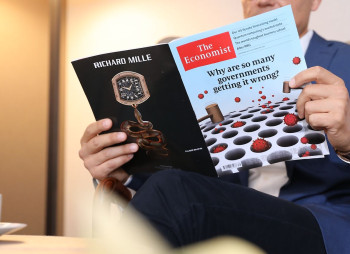International aid has been crucial for Ukraine’s survival during wartime, but private investment is essential for the country’s long-term reconstruction and modernization. Despite the challenges posed by ongoing conflict, there is significant interest in investing in Ukraine, though large-scale investments are likely to occur postwar. Meanwhile, creative solutions are needed to attract private investment, such as focusing on less risky regions and leveraging new strategies like the data platform launched by the Ukrainian government to analyze war risks. Impact investing is gaining traction as a means to support resilient, long-term recovery, prompting a deeper exploration of its role and definition in war-torn areas like Ukraine.
What is impact investing?
Within the family of investments, impact investing is a specific strategy that seeks to achieve positive environmental and social outcomes along with financial gains. Despite its potential, impact investing represents only 2 percent of global assets under management, totaling $2.3 trillion in 2020. Although demand is high, the distribution of impact capital is skewed, with the majority in developed markets and a smaller portion directed toward emerging markets, including just 6 percent toward Eastern Europe and Central Asia. In this context, the international community, in collaboration with the Ukrainian government, could devise new strategies and prioritize smaller impact investments in less risky regions of Ukraine that are not in active combat.
What was the impact investment market in Ukraine before the war?
Before the 2022 invasion, Ukraine struggled to attract foreign direct investment (FDI), including impact investments, due to numerous systemic challenges including corruption and the lack of a credible judicial system. The cumulative effect of longstanding issues and new geopolitical tensions continued to make Ukraine less attractive to foreign investors compared to other Eastern European nations. The market for impact investment in Ukraine remained very small. As of 2020, only 1,000 enterprises that generate social impact operated in Ukraine.
Some examples of impact investment funds include the Western NIS Enterprise Fund (WNISEF) and Horizon Capital. Since 2016, WNISEF—a regional fund funded by the U.S. government via the United States Agency for International Development specializing in investing in small- and medium-sized enterprises (SMEs) in Ukraine and Moldova—has offered a low-interest loan program through its Impact Investing Program in collaboration with two bank partners, state-owned Oschadbank and commercial Kredobank. Eligibility for the program requires that the companies employ members of a vulnerable population and/or that a percentage of the profit goes to a social cause. The first beneficiary was the bakery “Horikhovyi Dim” in Lviv, which received the equivalent of $28,191 to support women in crisis with jobs, the opening of a social canteen, and accommodations in its own social hostel. In 2016, the program received 96 applications and funded three of the enterprises. More broadly, since its inception in 1993 and through all its programs, WNISEF invested over $190 million in 143 companies and unlocked $2.3 billion for Ukrainian and Moldovan companies.
Similarly, Horizon Capital, a U.S. private equity firm created in 2006 that invests in Ukraine and the nearby region, raised a $200 million hard cap for its third fund, Emerging Europe Growth Fund III, L.P. (EEGF III) in 2019. This fund focuses on fast-growing and export-oriented competitive Ukrainian companies in sectors such as tech (primarily), information technology (IT), light manufacturing, agriculture, e-commerce, healthcare and pharma, consumer goods, and financial services. EEGF III won the 2022 Financial Times/International Finance Corporation Transformational Business Award in the Impact Investing Category.
How has the wartime context affected investment needs in Ukraine?
Following Russia’s full-scale invasion, Ukraine’s economy suffered greatly, halting FDI and stalling the mergers and acquisitions market, with most 2021 transactions canceled. The IT sector was an exception, continuing to grow in 2022 due to its ties to U.S. and European headquarters and relocation potential. However, the exodus of skilled, working-age Ukrainians strained all sectors, including IT. Key industries like metallurgy, agriculture, retail, construction, logistics, processing, and mining lost much of their investment appeal. Economic challenges were compounded by limited access to affordable credit, scarce equity investments, and low financial literacy among SME owners.
The lack of insurance and reinsurance availability has stifled foreign investment, with the private insurance market focusing mainly on health and non-war-related risks. Global reinsurers like Munich Re and Swiss Re have withdrawn, further reducing capacity. Local insurers’ capacity of €50–60 million falls short of meeting current needs or supporting private investment.
Despite significant challenges, Ukraine’s economy rebounded in 2023 with 5.8 percent GDP growth, expected to continue into 2024. SMEs, which constitute nearly all registered businesses in Ukraine, have shown resilience: most of the businesses (77 percent) now operate without restrictions despite ongoing war. The government is aligning regulations with international standards and the European Union has facilitated full trade liberalization with Ukraine, lifting import duties and quotas. While investment risks remain due to the conflict, less than 20 percent of Ukrainian territory is conflict-affected, leaving substantial regions, especially in the west, viable for business and investment opportunities, including impact investors.
What are some opportunities for impact investment during wartime?
The investment potential in Ukraine is significant because of its large consumer market, highly competitive workforce, strategic geographical location, and abundant natural resources. Six areas worth investing in, and which would bring about sustainable and equitable development in Ukraine, are technology (especially the IT industry and digital economy), infrastructure, renewable energy, healthcare, education, and agriculture.
Despite the ongoing war, some notable private investments took place from 2022 to 2024, including Unilever’s €20 million factory, ArcelorMittal’s €40 million manufacturing facility, Kingspan’s $280 million project, and Nestlé’s $42 million production plant funded by a European Bank for Reconstruction and Development (EBRD) loan. Although these examples might not fit into the traditional definition of “impact investing,” to some observers, any new investment in wartime can be considered impact investing.
How can Ukraine attract impact investment during wartime?
These examples reflect exceptions more than a rule. For private investors and companies looking to do business in Ukraine in 2024, there are a series of instruments and initiatives that could help attract more impact investors to the country. Many investors are curious to invest in Ukraine but face bottlenecks:
- Lack of Bankable Projects: The shortage of projects that meet investor criteria significantly hampers investment, stalling progress and economic recovery despite the potential of Project Preparation Facilities (PPFs) to stimulate investment.
- Legal Hurdles: The absence of a robust legal framework for impact investing increases uncertainty and risk for investors, making them hesitant to commit capital to Ukrainian projects. Establishing clear legal guidelines and protections is essential.
- Lack of Financial Instruments: The insufficient availability of financial tools, including blended finance and specific war insurance, deters the necessary capital influx for reconstruction, highlighting the need for comprehensive solutions.
- Risk Aversion: International financial institutions (IFIs) are too risk averse to encourage investment in a war economy, requiring new strategies to lower the cost of risk and secure private investment.
To accelerate private sector investment in Ukraine before the war ends, public sector leadership is essential in blending finance to share risks. Public-private partnerships should form the core of Ukraine’s impact investing strategies, catalyzing investments through grants, loans, risk insurance, bonds, and guarantees; aligning regulatory laws with international standards; and enhancing transparency and governance in the investment landscape. Such measures can mitigate risks to levels comparable with other emerging markets. A combination of debt and equity financing can help provide a more flexible and adaptive approach to capital structuring.
Blended finance, combining resources from development finance institutions and the private sector, can overcome market failures and mobilize investment. Major public impact investments in this realm are led by multilateral institutions like the International Finance Corporation, the EBRD, and the European Investment Bank, as well as bilateral development finance institutions (DFIs) such as the U.S. Development Finance Corporation, the Japan International Cooperation Agency, and Germany’s Kreditanstalt für Wiederaufbau (KfW).
A notable example is the International Finance Corporation’s $2 billion Economic Resilience Action Program for Ukraine’s private sector and its $30 million investment in the Horizon Capital Growth Fund IV. This initial commitment helped attract global investors, culminating in $350 million by February 2024, primarily supporting tech and export-oriented SMEs in Ukraine and Moldova.
The Ukraine Development Fund, created by BlackRock and JPMorgan, aims to attract private investment to sectors like energy, infrastructure, manufacturing, agriculture, and IT by leveraging “concessionary capital” from international financial institutions. Targeting $500 million to $1 billion in catalytic capital, the Ukraine Development Fund plans to draw $2 billion in private capital, starting project funding in 2025.
A significant obstacle is the lack of insurance coverage for war and political risks. Publicly funded insurance products, such as the Development Finance Corporation’s $450 million in war risk insurance and various guarantees through local banks, have facilitated investments. International support includes G7 leaders, the European Commission, and national export credit agencies insuring their companies in Ukraine. Key initiatives include the EBRD’s risk-sharing facility with joint stock company OTP Bank and the World Bank’s Multilateral Investment Guarantee Agency, which has provided $215 million in guarantees through the Support for Ukraine’s Reconstruction and Economy Trust Fund.
Despite these efforts, coverage remains fragmented and inadequate, necessitating better coordination among Ukraine’s DFI and IFI partners. The EBRD, alongside the United Kingdom, is developing a pilot project for war risk insurance in Ukraine. The U.S. Development Finance Corporation and the Multilateral Investment Guarantee Agency also established a consultative group to explore political risk insurance, including war risk insurance, for Ukraine.
While the Ukrainian government is eager to promote foreign investments, the absence of a legal framework for impact investing deters the establishment of such projects in Ukraine. Clear guidelines and protections are essential to facilitate the development of investment opportunities which can improve social, environmental, or economic conditions in Ukraine.
With regard to developing a pipeline of bankable projects for Ukraine, project preparation facilities (PPFs) could be a key mechanism to accelerate this process.
How can donors accelerate project preparation and create a pipeline of bankable projects?
More than 400 global companies pledged support for rebuilding Ukraine’s war-torn economy at the Ukraine Recovery Conference in London last June—but little private capital has been deployed as of early 2024. One way for institutional donors and private investors to identify bankable projects and accelerate impact investment is to make use of PPFs—a funding mechanism designed to support the development of investment-ready projects that can generate positive social or environmental impacts.
The primary goal of a PPF is to bridge the gap between project ideation and implementation by providing technical assistance, feasibility studies, and early-stage financing to help high-impact projects become bankable and attractive to mainstream investors. PPFs are especially important for impact investing in Ukraine because they help address several key challenges and barriers inherent to impact investing in a high-risk context, while enhancing the effectiveness, scalability, and alignment of impact investments with global development priorities.
Several PPFs are helping stimulate investment in Ukraine. The Ukraine Development Fund is supported by a PPF to create projects attractive to investors. The European Union’s Ukraine Facility, launched on February 1, 2024, has earmarked 50 billion euros for Ukraine’s recovery, with 8 billion euros set aside to foster private investments through the “Ukraine Investment Facility,” a de-risking tool to enhance IFI-led investments. The EBRD’s Infrastructure Project Preparation Facility collaborates with the International Finance Corporation advisory team on public-private partnerships, focusing on Black Sea ports like Olvia and Kherson. About €3 million has been dedicated to project preparation, with initiatives expected to attract up to €200 million in private investments into port terminal development, notably aiding the grain export sector.
How can impact investors reach Ukrainian micro, small, and medium enterprises (MSMEs)?
One area where impact investors can make a difference is supporting MSMEs. There’s a pressing need for more such funds to attract broader private capital for MSMEs. This requires reevaluating and potentially lifting existing restrictions on creating new investment funds in Ukraine, such as prohibitions on first-time, one-country, and one-sector funds, and limits on capital concentration. Additionally, forming an intergovernmental group including international financial bodies, investors, and SMEs could foster regular dialogue on MSME investment and address challenges like infrastructural gaps and supply chain disruptions. Special focus should be given to MSMEs that advance from raw material export to domestic processing, enhancing the value of local and regional market products.
Several private impact funds in Ukraine focus on MSMEs. The Horizon Capital Growth Fund IV targets asset-light, export-oriented tech companies, with over 80 potential investments. The WNISEF, with a $285 million fund and 29 years of experience in Ukraine and Moldova, supports MSMEs and partners with the Ukraine Startup Fund to provide up to $50,000 grants for tech startups.
Efforts to support MSME financing in Ukraine include several key initiatives. The EBRD is enhancing bank capital for MSMEs, focusing on sustainable technologies and including startups in procurement processes. In May 2024, the EBRD announced that it would be providing an unfunded portfolio risk-sharing facility to ProCredit Bank Ukraine. This facility will cover up to 50 percent of ProCredit Bank Ukraine’s credit risk on newly issued sub-loans totaling €70 million to Ukrainian businesses in the agriculture, manufacturing, transport, and pharmaceuticals industries. Additionally, up to 15 percent of the risk-shared loans will support SMEs in making long-term investments in European Union–compliant and green technologies.
Similarly, the U.S. Development Finance Corporation has mobilized $250 million for MSME capital access and offers guarantees like a $15 million package to Bank Lviv. It also provides war risk insurance and is developing investment-attractive private sector projects. Additionally, the German KfW development bank has invested €150 million in MSMEs since 2021 through its business development fund, supporting sectors such as agriculture. The German government plans to develop the business development fund into a national economic recovery institution similar to Germany’s KfW. Finally, the “Business Bridge” project, launched by the European Commission in March of this year, aims to provide 3.75 million euros to up to 1,500 Ukrainian SMEs. Each would receive financial assistance of 2,500 euros covering business services.
How can impact investing help Ukraine’s efforts to rebuild?
The untapped market for impact investing in Ukraine presents a significant opportunity for driving the nation’s long-term reconstruction and modernization. Despite the ongoing war and existing challenges, there are viable pathways to attract private investment. Creative solutions, such as blended finance, risk mitigation tools, and robust legal frameworks, are essential to overcoming barriers and mobilizing capital. Public-private partnerships, effective coordination among international financial institutions, and strategic investments in less risky regions can catalyze impactful investments.
The international community and the Ukrainian government should prioritize building a pipeline of bankable projects and enhancing the investment landscape’s transparency and governance. Supporting MSMEs, leveraging PPFs, and addressing the insurance coverage gap are crucial steps in fostering a resilient and thriving Ukrainian economy. By implementing these strategies, Ukraine can attract the necessary impact investments to achieve sustainable and equitable development, even amid wartime challenges.






